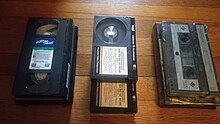This article has multiple issues. Please help improve it or discuss these issues on the talk page. (Learn how and when to remove these messages)
|
 | |
 A Video 2000 videocassette A Video 2000 videocassette | |
| Media type | Magnetic cassette tape |
|---|---|
| Encoding | PAL |
| Standard | 625 lines |
| Developed by | Philips Grundig |
| Usage | Home movies |
| Released | 1979; 46 years ago (1979) |
| Discontinued | 1988; 37 years ago (1988) |
Video 2000 (also known as V2000, with the tape standard Video Compact Cassette, or VCC) is a consumer videocassette system and analogue recording standard developed by Philips and Grundig to compete with JVC's VHS and Sony's Betamax video technologies. It was designed for the PAL color television standard, but some models additionally handled SECAM. Distribution of Video 2000 products began in 1979 exclusively in Europe, South Africa and Argentina and ended in 1988.
Although some initial models and advertising featured a mirror-image "VCR" badge based on the logo of Philips's earlier Video Cassette Recording (VCR) system, Video 2000 was an entirely new (and incompatible) format, which incorporated many technical innovations. Despite this, the format was not a major success and was eventually discontinued, having lost out to the rival VHS system in the videotape format war.
The Video Compact Cassette
Philips named the videotape standard Video Compact Cassette (VCC) to complement its landmark audio Compact Cassette format introduced in 1963, but the format itself was marketed under the trademark Video 2000.
Despite the name, VCCs are marginally larger than VHS cassettes—shorter, but thicker and deeper. They have two co-planar reels containing half-inch (12.5 mm) wide chromium dioxide magnetic tape. The format used only half (6.25 mm) of the half-inch tape on a given "side", and so it is occasionally referred to erroneously as a quarter-inch tape format, despite its physical tape width. The cassette can then be flipped over to use the other half of the tape, thus doubling playing time.
Format and features

Dynamic Track Following (DTF) eliminated the need for a separate control track and enabled the video heads to accurately follow the recorded tracks on the tape during playback. Therefore, by design V2000 machines do not require a video tracking control.
Launch

A key intention of the V2000 format, thanks to DTF, was tape compatibility. A tape from any machine should play perfectly on any other machine. However, when the VR2020 reached the shops it was discovered that its audio head was 2.5 mm out of position compared to that on Grundig's Video 2×4 (Grundig V1600). This meant that the sound would be out of sync with the picture when played back on the other type of machine. Both manufacturers' hastily moved the audio head 1.25 mm to a common position, but compatibility issues remained for recordings made on the first generation of machines.
Machines


- Philips VR2020
- Philips VR2022
- Philips VR2026 (PAL/SECAM tuner—recorded SECAM as PAL)
- Philips VR2340
- Philips VR2324
- ITT VR681
References
- Daniel, Eric D.; Clark, Mark H.; Mee, C. Denis, eds. (31 August 1998). Magnetic Recording: The First 100 Years. IEEE Press. p. 192. ISBN 9780780347090. Retrieved 22 January 2020.
- Rhodes, Phil (Mar 19, 2021). "Betamax vs VHS was only the tip of the iceberg for the format wars of the 80's". RedShark.
- Video History: V2000—The format that came third in a two-horse race (YouTube). Techmoan. 9 September 2018. Event occurs at 4:59–5:08. Retrieved 24 October 2018.
- Video History: V2000—The format that came third in a two-horse race (YouTube). Techmoan. 9 September 2018. Event occurs at 5:17–5:25. Retrieved 24 October 2018.
- "V2000 PALsite" (accessed January 3, 2007) lists the VCC dimensions: 183 mm × 26 mm × 110 mm.
- VHS_e.htm "VHS Community: VHS 1976" (accessed January 3, 2007) lists the VHS cassette dimensions: 188 mm × 25 mm × 104 mm.
- "Video 2000 / Video Compact Cassette (1979–1988)". Museum of Obsolete Media. 20 May 2013. Retrieved 15 December 2019.
- Nmungwun, Aaron Foisi (1989). Video Recording Technology: Its Impact on Media and Home Entertainment. ISBN 0-8058-0360-2. Retrieved 22 January 2020.
- Dean, Richard. Home Video (Newnes Technical Books, 1982), page 18
- "Video Recorder VR2020 R-Player Philips". Radiomuseum. Retrieved 2023-05-26.
- "Video Recorder VR2022S R-Player Philips". Radiomuseum. Retrieved 2023-05-26.
- "Videorecorder VR2026/53 R-Player Philips Radios". Radiomuseum. Retrieved 2023-05-26.
- "Video-Recorder Stereo VR2340/51 R-Player Philips Radios". Radiomuseum. Retrieved 2023-05-26.
- "Video Cassette Recorder 23VR24 R-Player Aristona". Radiomuseum. Retrieved 2023-05-26.
- "Videorecorder 681 Stereo VR 681/00 R-Player ITT". Radiomuseum. Retrieved 2023-05-26.
External links
- Video 2000 page at Total Rewind—The Virtual Museum of Vintage VCRs
- V2000 PALsite—Information about the V2000 video format
- "Europe's Video Recorder Takes on the Japanese", New Scientist July, 5, 1979, page 25
| Philips | |||||
|---|---|---|---|---|---|
| Divisions and subsidiaries |
| ||||
| Joint ventures and shareholdings |
| ||||
| Brands, products and standards |
| ||||
| People | |||||
| Places | |||||
| Related topics | |||||